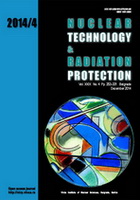
A STUDY OF INDOOR RADON LEVELS AND RADON EFFECTIVE DOSE IN DWELLINGS OF SOME CITIES OF GEZIRA STATE IN SUDAN

Vol.
XXIX, No. 4, Pp. 253-331
December 2014
UDC 621.039+614.876:504.06
ISSN 1451-3994
Pages: 307-312
Authors: Abd-Elmoniem Ahmed Elzain
Abstract
Exposure to natural sources of radiation, especially 222Rn and its short-lived daughter products has become an important issue throughout the world because sustained exposure of humans to indoor radon may cause lung cancer. The indoor radon concentration level and radon effective dose rate were carried out in the dwellings of Medani, El Hosh, Elmanagil, Haj Abd Allah, and Wad Almahi cities, Gezira State – Central Sudan, in 393 measurements, using passive integrated solid-state nuclear track devices containing allyl diglycol carbonate plastic detectors. The radon concentration in the corresponding dwellings was found to vary from (57 ± 8) Bq/m3 in Medani to 41 ± 9 Bq/m3 in Wad Almahi, with an average of 49 ± 10 Bq/m3. Assuming an indoor occupancy factor of 0.8 and 0.4 for the equilibrium factor of radon indoors, we found that the annual effective dose rate from 222Rn in the studied dwellings ranges from 1.05 to 1.43 mSv per year and the relative lung cancer risk for radon exposure was 1.044%. In this research, we also correlated the relationship of radon concentration and building age. From our study, it is clear that the annual effective dose rate is larger than the “normal” background level as quoted by UNSCEAR, lower than the recommended action level of ICRP, and less than the maximum permissible dose defined by the International Atomic Energy Agency.
Key words: indoor radon, effective dose, CR-39, relative risk, lung cancer
FULL PAPER IN PDF FORMAT (503 KB)